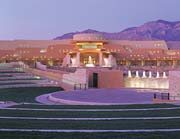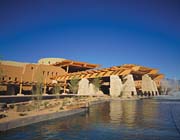

The goal of the design was to assimilate the facility with the community's ethnicity, according to Project Architect Kristina Robinson of Leo A Daly in Phoenix, AZ. “In working with the Pueblo [tribe], we tried to reflect the vision and culture of the Pueblo in the design,†said the architect. “That included its placement in the landscape and the vocabulary of the architecture. The goal was really to create a unique and dynamic design that was a positive reflection of the tribe and its values.â€
Another element for the design was to use only natural materials. “We had investigated the use of some faux or some simulated material, but we really wanted a true representation of the materials that were in the facility,†explained Robinson. “Once we made that decision, then we looked to what was available regionally, and [the sandstones] are both regionally available stones. So again, [the goal was] trying to pull in elements of their culture and their history through the use of natural material as well.â€
The only stones that were in contention for the exterior facade were various sandstone. “We presented a variety of sandstones to the owners,†said the architect. “Some of them were more the colors of Red Rock, and some of them were grayer in tone. Ultimately, the decision came to not only the color waves that were in the Los Lunas and the Deer Creek sandstone, but also the fact they were local stones.â€
The majority of the sandstone was employed for bridges and retaining walls, according to Robinson. “It was also used as architectural elements on the building itself -- column wraps, the base of the wall in the entry rotunda, which is quite a large space, and also walls throughout the building,†she said.
The blend of the two stones was placed in a random pattern of 70% Los Lunas and 30% Deer Creek. “For example, say we had a couple of palettes of stone that we were using on any given column, a certain percentage of that was the Los Lunas and the other was the Deer Creek, and as they are installing the stone, they kind of mixed it up,†explained the architect. In total, over 100,000 square feet of the two sandstones were employed for the facility.
At the main entrance of the building, Roeder Buff sandstone flagging was employed for the exterior flooring. The material was supplied through Rocky Mountain Stone Co., Inc. of Albuquerque, NM, and quarried by Dunbar Stone of Ashfork, AZ, according to Scott Lardner, President of Rocky Mountain Stone Co., Inc.
Additionally, the use of natural stone was carried inside for several interior applications. Inside the casino, the blend of Los Lunas and Deer Creek sandstone was employed for columns. “There are granite countertops throughout the building, including the restrooms and throughout the food and beverage facility,†said Robinson. “In the specialty restaurant, the bar countertop is Antique Labrador with flecks of Labradorite, which is really stunning.â€
The numerous natural stone countertops were fabricated and installed by Rocky Mountain Stone Co., Inc. “The main entry reception/information desk used Tabasco travertine from Mexico,†explained Lardner. Along with the information desk, the Tabasco travertine was used for the patterned apron, change booth transaction tops and the phone booth tops, according to the fabricator. “The sandblasting of the pattern for the entry tops and the poker tops was done by Bill Worthen of Worthen Memorials here in Albuquerque,†explained Lardner.
Natural stone was also employed in other areas of the interior space. “Madura Gold granite was used for the vanity tops in all the public restrooms,†said Lardner. “Imperial Red granite was used for the bingo tops and the poker room tops.
“The main bar is a serpentine shaped Indian Absolute Black granite field with a “river†of Acquiem Blue granite. The bar has a 4-inch beveled armrest along the front edge, and an integral stone drink rail along the inside edge, all out of Absolute Black. The bar in the specialty restaurant is similar, with labradorite called Labrador Antique, as the field, and Imperial Red as the river down the middle. The architect originally wanted to insert river rock pebbles into the center of the bar, but when she saw the Acquiem Blue, it made for a perfect solution.â€
Feedback to the design has been very good, according to the architect. “The reaction has been very, very positive,†she said. “There have been very enthusiastic reviews from the owner. Our only challenge was trying to take the facility -- whose vocabulary and design motif was reflective of the Pueblo architecture -- and convert that into a building that is the size of several football fields. We were converting something that might be 20 x 20 feet to a 210,000-square-foot facility.â€
End box:
Pueblo Sandia Casino, Albuquerque, NM
Architect: Leo A Daly, Phoenix, AZStone Supplier/Fabricator: New Mexico Travertine Inc., Belen, NM (Los Lunas and Deer Creek sandstones)
Stone Fabricator/Installer: Rocky Mountain Stone Co., Inc., Albuquerque, NM (granites, travertine, labradorite)
Stone Quarrier: West Coast Lumber/Stone, Alto, NM (Los Lunas and Deer Creek sandstones)
Stone Quarrier: Dunbar Stone, Ashfork, AZ (Roeder Buff sandstone)
Stone Installer: Beaty Construction, Albuquerque, NM (Los Lunas and Deer Creek sandstones)